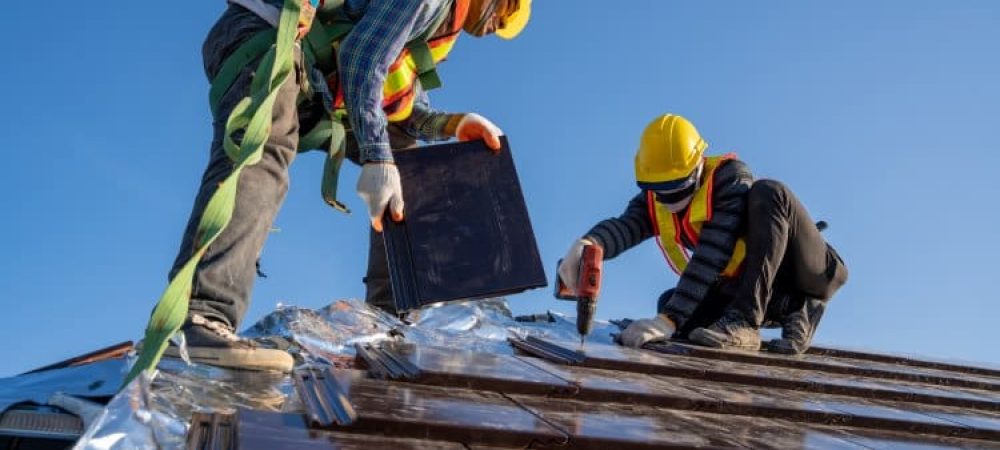The Stakes for Illinois Businesses
Commercial roofs are not just big versions of residential roofs. They face different stress, design, and maintenance issues. In Illinois, the stakes are high. The state gets heavy snow, harsh winds, hot summers, and strong storms. Roofs must survive all four seasons.
The National Oceanic and Atmospheric Administration reported that Illinois faced more than 50 major weather disasters since 2000. Each one put strain on buildings, especially flat and low-slope commercial roofs. Business owners who wait until problems appear risk more than a leaky ceiling. They risk inventory, equipment, and customer trust.
Flat Roofs and Their Weak Spots
Water Pooling
Most commercial roofs are flat or low-slope. That design saves cost but creates a challenge. Water does not run off easily. It pools in low spots. Over time, standing water breaks down materials and seeps through seams.
Membrane Damage
Many Illinois businesses use rubber, TPO, or modified bitumen membranes. These work well until they crack or pull away. Extreme cold and hot sun cause expansion and shrinkage. That movement weakens seams and flashing.
Heavy Loads
Snow is a major factor in Illinois. A cubic foot of wet snow weighs about 20 pounds. A roof can carry thousands of pounds after a big storm. Weak spots collapse under the load.
Real-World Stories
One warehouse manager in Joliet learned this the hard way. “We skipped our fall inspection. That winter, snow pooled in one corner. The weight tore a seam, and water dripped onto pallets of electronics. The loss was over $40,000 before we even fixed the roof.”
Stories like this are common. Maintenance often gets pushed back when budgets are tight. But the cost of inaction is usually higher.
The Cost of Ignoring Problems
The average cost of replacing a commercial roof in Illinois runs from $5 to $10 per square foot, depending on materials. For a 20,000-square-foot warehouse, that can reach $200,000. By contrast, preventive maintenance may cost just a few cents per square foot each year.
Insurance claims do not always cover neglect. If an insurer finds evidence of poor maintenance, payouts can shrink. A business owner in Springfield described being denied coverage after a storm. “The adjuster showed me photos of our gutters packed with debris. They said it counted as neglect. We paid $80,000 out of pocket.”
Weather Challenges in Illinois
Freeze-Thaw Cycles
Illinois winters bring freeze-thaw cycles. Water enters tiny cracks. When it freezes, it expands. That expansion widens gaps and breaks down roofing materials.
High Winds
Wind gusts over 60 mph are not rare. They lift flashing, peel back membranes, and scatter debris across roofs. Once wind gets under a seam, it pulls the surface apart.
Summer Heat
Black flat roofs absorb sunlight. In Chicago, rooftop surfaces can hit 160°F in July. Heat speeds up aging, causes blisters in membranes, and weakens adhesives.
What Business Owners Can Do
Schedule Regular Inspections
Check commercial roofs at least twice a year. Spring and autumn are ideal. After big storms, do a quick follow-up. Look for standing water, torn seams, or clogged drains.
Clear Drains and Gutters
Blocked drains trap water on flat roofs. Clear them before snow and after heavy rains. Water should flow freely off the surface.
Reinforce Weak Spots
Pay attention to flashing around HVAC units, skylights, and vents. These are common leak points. Replace damaged flashing right away.
Plan for Snow Loads
Know the weight limit of your roof. Keep tools or services ready to clear snow when it builds up. A few hours of snow removal is cheaper than repairing a collapse.
Keep Records
Document inspections with photos. Keep receipts from maintenance and repairs. This proves care if you need to file an insurance claim.
The Role of Professional Roofers
Commercial roofs are large, complex systems. Many problems are not obvious to an untrained eye. A professional roofer can spot early signs of trouble.
Tiffany Wasso, who started Done Right Roofing in Bridgeview, and now operates at 4721 S. Cicero Ave, Chicago, IL 60632, explained how regular checks can save clients money. “We inspected a retail building in Oak Lawn last spring. The owner thought everything was fine. We found a seam pulling apart behind an HVAC unit. Fixing it cost $600. If they waited until winter, it would have been thousands.”
Why Prevention Pays
Proactive care adds years to a roof’s life. A 20-year roof can last 25 years or more with steady maintenance. For a large property, that extra time can mean saving hundreds of thousands.
It also reduces downtime. Roof leaks often force businesses to shut down sections of a building. Lost hours, ruined stock, and angry customers add up fast. Preventive care avoids these headaches.
Planning Ahead
Budget for Maintenance
Set aside money each year for roof care. Treat it like any other operating expense. Skipping one year often leads to bigger bills later.
Train Staff to Spot Signs
Teach facility managers or staff to look for stains, leaks, or pooling water. Early reporting makes repairs cheaper and faster.
Consider Upgrades
Reflective coatings reduce heat stress. Stronger membranes resist tears. Upgrading when budgets allow extends roof life.
Conclusion
Illinois weather is tough on commercial roofs. Flat designs, freeze-thaw cycles, and heavy snow create constant pressure. Ignoring maintenance leads to costly failures.
Business owners can take control with regular inspections, drain cleaning, snow planning, and quick repairs. Professional roofers add expertise that catches hidden issues early.
The numbers make it clear. Spending a little on prevention saves thousands later. A strong roof protects more than a building. It protects staff, products, and business reputation.


